For beginners embarking on their surfing journey, selecting a surfboard for beginners that offers balance between stability and ease of handling is paramount. A surfboard tailored for novices should be long (ranging from 7 to 9 feet), providing enhanced floatation and paddling efficiency, which are essential for catching waves and maintaining speed. The board's thickness also plays a role in buoyancy, with a moderate thickness offering both resilience against dings and a forgiving ride. A soft top deck is crucial for safety, along with secure grip features that protect beginners during falls. Characteristics such as a wider nose and tail, a rounded tail rocker, and a moderate amount of rocker contribute to the board's performance. A single to double fin setup ensures stability and ease in handling turns. High-density polyurethane foam cores with fiberglass skin and optionally epoxy resin encasements offer both durability and lightweight performance. Designs like those from Softop surfboards, BIC Sport, Wavestorm, and South Core Designs cater to beginners, ensuring a smooth learning process and accommodating practice and progression while also offering sustainable options for eco-conscious surfers. These surfboards for beginners are designed to make the initial steps into wave riding an enjoyable and injury-minimized experience across different coastal environments.
Embarking on the exhilarating journey of coastal surfing? A surfboard for beginners is your gateway to riding waves with confidence. This article demystifies the essentials, from the key features that enhance stability and ease of learning, to the types of surfboards best suited for newcomers navigating coastal waters. Discover how to select the ideal size and shape for your initial board, and learn about the robust materials that promise durability without compromising performance. Additionally, explore top brands crafting beginner-friendly surfboards designed to elevate your coastal adventures. Dive into the world of surfing with insights tailored to transform your experience from tentative to triumphant.
Understanding the Basics of a Surfboard for Beginners
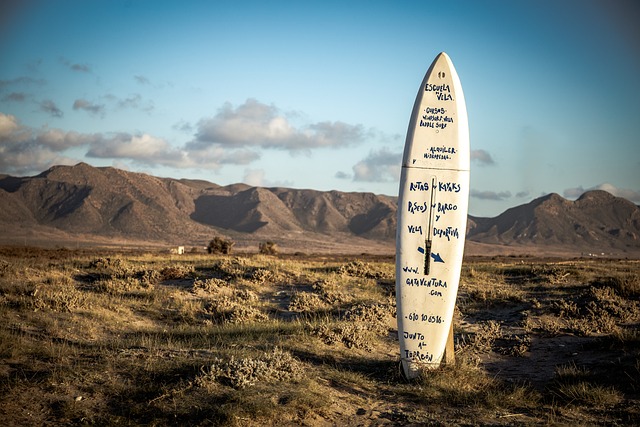
When embarking on the journey of coastal surfing, selecting the right surfboard is paramount, especially for beginners. A beginner’s surfboard should be designed with stability and ease of use in mind. Typically, a longer board, ranging from 7 to 9 feet, offers increased floatation and paddling power, making it more accessible for those new to the sport. The thickness of the board also plays a role; a thicker board provides additional buoyancy, which can be particularly helpful when learning to catch waves and stand up. Additionally, soft boards are often recommended for beginners due to their durable, foam-based construction that cushions falls and reduces the risk of injury.
The choice of surfboard fins is another aspect to consider for beginners. A thruster setup, which includes three fins, offers a balance between stability and maneuverability, making it ideal for new surfers. This configuration helps in maintaining speed and direction once you’ve popped up onto the board, a crucial element when mastering the basics of surfing. The volume of the board, which refers to the amount of water it displaces, is also an important factor for beginners. A higher volume board can carry more weight, providing greater confidence as you develop your skills and strength in the water. Understanding these aspects of a surfboard will help ensure a safer and more enjoyable learning experience on the waves.
Key Features to Look for in a Beginner's Surfboard
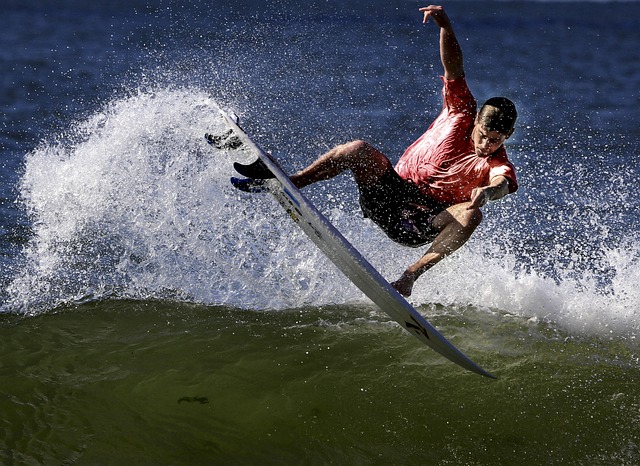
When embarking on the journey of mastering the art of surfing, selecting the right beginner’s surfboard is paramount for a safe and enjoyable learning experience. A surfboard designed for novices should boast a user-friendly design that ensures stability and buoyancy, allowing the rider to practice standing up and maneuvering without constant battles against the ocean. An ideal board for beginners typically features a larger volume, which translates to greater floatation and easier paddling into waves. The length of these boards tends to be around 8 to 9 feet, offering both stability and manageable weight.
In addition to ample floatation, beginner surfboards should have a soft top deck with a grip to prevent slipping and protect surfers from bruises or abrasions when they inevitably wipe out. A wider nose and tail, along with a rounder tail rocker, help in maintaining control and direction, even on smaller waves. The thickness of the board also contributes to its buoyancy, which should be between 2.75 to 3 inches for most beginners. It’s advisable to opt for a board with a single fin setup or a thruster fin configuration that is removable and adjustable, as this provides both stability and the potential to transition to a more performance-oriented setup as skills advance. Considering these features will help beginners find a surfboard that not only complements their learning process but also enhances their progression in the sport of surfing.
Types of Surfboards Suitable for Coastal Surfing as a Novice
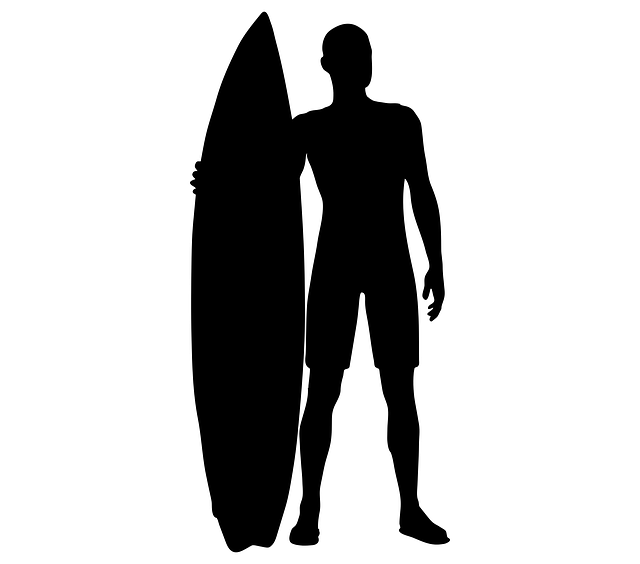
When embarking on the journey of coastal surfing as a novice, selecting the right surfboard is paramount to a safe and enjoyable experience. A beginner-friendly surfboard should possess certain characteristics that cater to learning and improving skills. Longboards are an excellent choice for beginners due to their size and buoyancy; they offer greater stability and are more forgiving when it comes to catching waves. Their length allows for easier paddling into waves, and their design typically includes a wider nose, which adds to the beginner’s confidence as they navigate the surf. Additionally, soft top longboards with a single fin setup are highly recommended; these boards combine safety with performance, making them ideal for those new to the sport.
Another suitable option for beginners in coastal surfing is a foam-core shortboard. These boards are shorter and more maneuverable than longboards, which can help transitioning surfers become accustomed to the feel of a “standard” surfboard. The foam core provides the necessary floatation for learning, while the softer rails protect against dings and offer a smoother ride. When choosing a foam-core shortboard, look for one with a wider template and a fuller outline; these features will aid in catching waves and provide stability during the initial stages of learning. Whether opting for a longboard or a foam-core shortboard, always ensure that the surfboard for beginners aligns with your specific needs and the conditions of the coastal waters you’ll be surfing.
How to Choose the Right Size and Shape for Your Surfboard

When selecting a surfboard, especially as a beginner, it’s crucial to consider the board’s size and shape, which can significantly impact your learning curve and overall experience on the waves. A surfboard for beginners should generally be longer and wider than those designed for advanced surfers. This ensures stability and floatation, making it easier to paddle into waves and maintain speed. The length of the board typically ranges from 7 to 9 feet; this size provides a broader platform and is more forgiving, reducing the likelihood of pearling (nose-diving) when catching waves.
In terms of shape, beginners benefit from boards with a moderate amount of rocker, which helps lift the tail off the water during turns, and a soft edge on the rails to minimize swing weight and make the board more manageable. Single to double fin setups are often recommended for novices as they offer stability and ease in controlling the board through turns. Additionally, a board with a slightly flattened hull design can be advantageous, offering both speed and ease of paddling. As you progress, you may opt for a shorter and more performance-oriented board, but for starters, prioritize a surfboard that balances stability with the ability to handle small to medium waves confidently. Remember, the right surfboard for beginners is one that allows you to enjoy the experience of surfing without unnecessary frustration or difficulty.
The Best Materials for Beginner Surfboards: Durability Meets Performance
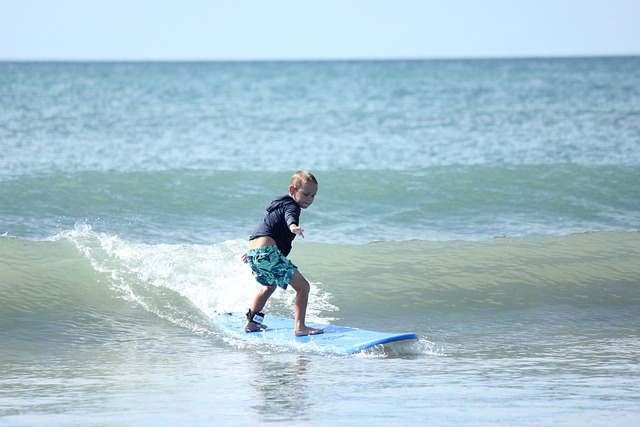
When selecting a surfboard for beginners, it’s crucial to balance durability with performance to ensure a safe and enjoyable learning experience. The ideal surfboard materials not only withstand the wear and tear of a novice surfer but also provide the floatation and stability necessary to master the basics. A high-density polyurethane foam core is often the preferred choice for beginner surfboards due to its lightweight properties and resilience against dings and dents that are common in the early stages of learning. This core is typically enclosed in a fiberglass wrap, which offers both stiffness and flexibility, essential for adapting to various wave conditions. Additionally, an epoxy resin can be used as it’s lighter and more forgiving than traditional polyester resins, making the board easier to handle and offering better performance in a wide range of surfing conditions.
For beginners, the shape of the surfboard is equally important. A soft-top longboard or a mini-mal is often recommended as they provide a larger surface area for stability, with a design that’s more forgiving of the surfer’s mistakes. The length of these boards helps in paddling effectively into waves, while their wider and thicker profiles ensure buoyancy and ease of use. Whether looking to ride small, gentle waves or starting to explore more challenging surf, materials like wood veneers for deck grip offer an additional layer of safety and comfort. These components not only enhance the board’s durability but also contribute to a more enjoyable introduction to the world of surfing.
Top Brands Offering High-Quality Surfboards for Beginners and Their Coastal Adventures
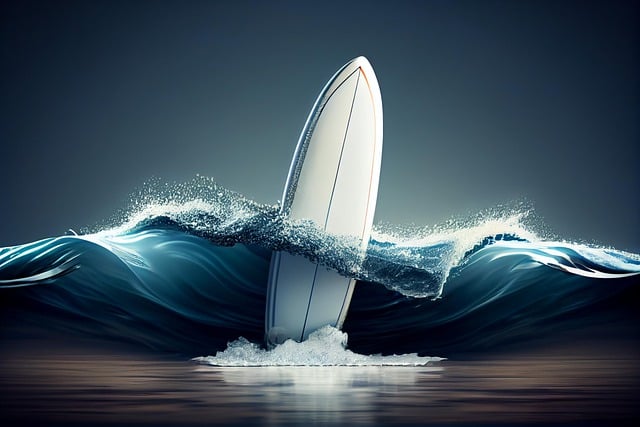
For those embarking on their coastal surfing journey, selecting the right surfboard is paramount to a satisfying experience. Among the top brands offering high-quality surfboards tailored for beginners are Softop Surfboards and BIC Sport. Softop’s range of foam boards, featuring their patented DeckSkin technology, provides durability and comfort, making them ideal for newcomers who are yet to master the basics. The soft top construction ensures a gentle learning curve, reducing the likelihood of injury should wipeouts occur. BIC Sport, with its rich heritage in surfing, offers beginner-friendly models that blend performance with forgiveness. Their boards are designed to glide smoothly across waves, offering a stable platform for surfers to practice and progress.
Another notable brand is Wavestorm, which has earned a reputation for producing reliable and accessible surfboards for beginners. Their boards combine quality materials with thoughtful design, resulting in a range that caters to various skill levels. For those seeking an eco-friendly option, South Core Designs stands out with their sustainable approach to crafting surfboards. Their focus on environmentally conscious production doesn’t compromise on the quality and performance needed for a rewarding surfing experience. Whether you’re feeling the Pacific swells or the Atlantic tides, these brands offer surfboards that will enhance your coastal adventures, allowing beginners to enjoy the thrill of surfing with confidence and ease.
